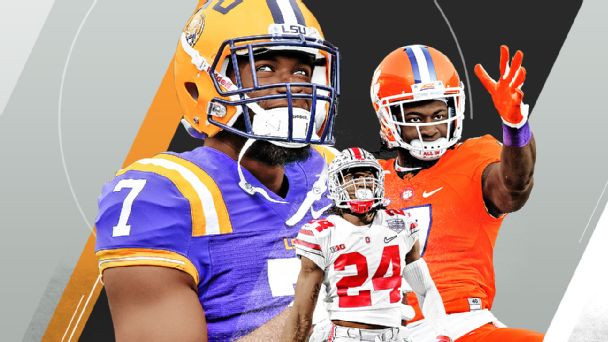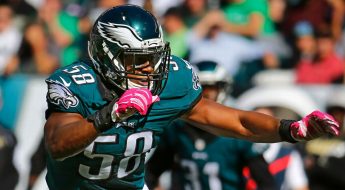NFL combine filled with wide receivers who could help Bucs offense

It’s no secret the Tampa Bay Buccaneers have a need at wide receiver, and the 2017 NFL scouting combine hasn’t disappointed, with a whopping 58 prospects at the position. Even without Western Michigan’s Corey Davis, who didn’t participate because he’s recovering from ankle surgery, this group features a lot of talent. Here’s how they performed in Indianapolis and how they’d fit in with the Bucs:
John Ross, Washington: In case you live under a rock, Ross beat Chris Johnson’s NFL combine 40-yard dash record, running an official time of 4.22 seconds (0.74 5-yard split). He sustained a cramp in his calf on the run, which meant his day was done. Now he’ll head home to undergo shoulder surgery. Ross’ 17 touchdown catches in 2016 were tied for most among all receivers in Power 5 conferences. According to ESPN Stats & Information, Ross scored a touchdown on 20 percent of his offensive touches last season, the highest rate among Power 5 conference players with at least 80 touches. Ross had a formal meeting with the Bucs. It should be noted, too, that a player the Bucs are expected to pursue in free agency, DeSean Jackson, has trained with and mentored Ross.
Curtis Samuel, Ohio State: Samuel ran the 40 in 4.31, and would have been the talk of Indy on Saturday had it not been for Ross’ earth-shattering 40 time. Samuel served as an H-back for the Buckeyes, but at 5-foot-11 and 197 pounds, that’s not doable at the next level. He led the Buckeyes with 15 touchdowns last year, but the thing that jumps out in watching his tape is his yards after the catch. He’s also incredibly versatile: He looks physically like he’d line up in the slot, but at other times that he could take handoffs as a running back and take pitches out of the backfield, and of course could go vertical with that top-flight speed — he’s not getting caught from behind. Bucs coach Dirk Koetter would have so many options with him. Samuel also had a formal meeting with the Bucs in Indianapolis.
JuJu Smith-Schuster, USC: Smith-Schuster ran a 4.54 40, posted a 32.5-inch vertical and had a 10-foot broad jump. Koetter has said he prefers bigger receivers, and Smith-Schuster fits the bill at 6-foot-2 and 220 pounds. He doesn’t have breakaway speed and looks to be more of a possession receiver. Smith-Schuster had 3,092 receiving yards over the last three seasons, second-most among Power 5 conference players. He’s plenty tough to bring down when the ball is in his hands (watch him stiff-arm defenders) and would be an asset over the middle with that kind of toughness. Koetter also said the Bucs need some yards after the catch. Smith-Schuster is a solid blocker, a plus for a run-heavy team like Tampa Bay. The most interesting thing with him, though, is that despite having great size, he’s not a player you see making many contested catches. He had a formal interview with the Bucs in Indy on Friday.
Zay Jones, East Carolina: He ran a 4.45 in the 40 (0.79 5-yard split) and had a 4.01 in the 20-yard shuttle, second-best among receivers. He turned in a 6.79 in the three-cone drill (13th among receivers). In the last two seasons, Jones produced 1,322 yards after the catch, the most of any player in college football. He also had 535 receiving yards after contact over the last three seasons, also the most among all players in college football.
Rodney Adams, USF: Adams turned in an official 4.44 in the 40, tied for ninth among receivers. In the last two seasons, Adams had 1,221 yards after the catch, third-most among all players in college football, and averaged 10.9 yards after the catch, more than any other player at the combine. He can make an immediate impact on special teams, where he averaged 26.3 yards per kickoff return over the last two seasons and produced a kickoff return for a touchdown against Navy in 2015. He met with the Bucs in Indianapolis.
Josh Reynolds, Texas A&M: Reynolds ran a 4.52 40 and posted a 37-inch vertical (fifth among receivers). That’s pretty darn good for a guy who’s 6-foot-3. What jumps out with Reynolds is his consistency and production, especially downfield, which is where the Bucs could stand to improve. He averaged 17 yards per reception last season. His 15 catches on balls traveling 30 or more yards downfield over the last three seasons were fifth-most in the Power 5. What may be most impressive of all is that in the last two seasons he was targeted for 22 passes of 30-plus air yards and he managed to haul in 15 of them. No other player comes close to that. He had 2,788 receiving yards over the last three seasons, fifth-most in the Power 5, and his 12 receiving touchdowns in 2016 were tied for eighth. His 377 receiving yards after contact over the last three seasons were fifth-most in college football. Reynolds met with the Bucs in Indianapolis.
Taywan Taylor, Western Kentucky: Taylor turned in a 4.50 40, dominated the three-cone drill with a 6.57, tops among receivers, and posted a 33.5-inch vertical. His 11-foot broad jump was also tied for sixth among receivers and his 11.23 60-yard shuttle was eighth. His 3,197 receiving yards over the last two seasons were most of any player in college football, as were his 34 receiving touchdowns. He could making a living on yards after the catch, and with his size (5-foot-11 and 198) and skill set, is probably best suited for a role in the slot.
NFL draft home page »
• 2017 NFL draft order »
• Mel Kiper Jr.: Mock 2.0 »
• Todd McShay’s Top 32
• McShay: Top prospects by position
• Todd McShay: Mock 2.0 »
• Mel Kiper Jr.’s Big Board »
• Mel Kiper Jr.: Top 10 by position »
• Pro day schedule for prospects »
• Underclassmen who have declared »
• NFL draft player rankings »
Chris Godwin, Penn State: Godwin turned in a 4.42 in the 40 (0.79 5-yard split), tied for fifth among receivers, and a 4.00 in the 20-yard shuttle, tied for tops at the position. Where he really shined was in his on-field work, matching effortless catch after catch. Godwin had 2,421 receiving yards over the last three seasons, ninth-most in the Power 5 during that span. His 303 receiving yards after contact over the last two seasons was third-most in college football and most in the Power 5. He’s a player who has shown great ability to catch the ball on passes deep down the field. At 6-foot-1 and 209 pounds, he’s got pretty good size.
Isaiah McKenzie, Georgia: McKenzie ran a 4.42 in the 40 (tied for fifth among receivers), posted a 36-inch vertical and had a 6.64 in the three-cone drill, second among wide receivers. At 5-foot-7 1/2 and 173 pounds, he faces a huge size disadvantage at the next level as a receiver, but he could make a big impact on special teams with five punt returns for touchdowns (third-most in SEC history) and a kickoff return for a touchdown in three years at Georgia. If the Bucs did utilize him on offense, it would have to be out in space, working out of the slot.
Ryan Switzer, North Carolina: Switzer had 2,566 receiving yards in the last three years, sixth-most among Power-5 players in that span. At 5-foot-8 and 181 pounds, his size is limiting at the next level, but he could be a productive slot receiver, although he doesn’t offer an upgrade over what the Bucs have already in Adam Humphries. Where he shines is on special teams. His five punts returned for touchdowns tied an NCAA single-season record.
Shelton Gibson, West Virginia: He was expected to be one of the faster players in the combine but turned in a 4.50; it was disappointing considering the way he hyped his own speed, saying that he’d top Johnson’s record. He didn’t come close, although his on-field speed is more eye-catching, and he’s got decent size at 5-foot-11 and 191 pounds. He finished first in the 60-yard shuttle with a 10.71. He is one of those receivers you could really air the ball out to downfield. In fact, his 17 receptions for 20-plus air yards and 13 for 30-plus air yards both were more than any other Power 5 player last season. Over the last three seasons, he produced 21 catches for 30-plus air yards, also tops among Power 5 players. His ability to make adjustments to the ball on tougher catches is impressive.
Artavis Scott, Clemson: Scott managed only a 4.61 in the 40, disappointing for a player with his level of production in college. His other numbers were also near the bottom (4.49 in the 20-yard shuttle and 12.06 in the 60-yard shuttle), something he’s going to have to answer for as pro days and private workouts get underway. He had a combined 2,149 yards after the catch over the last three seasons, more than any other player in college football during that span. His 534 receiving yards after contact over the last two seasons were second-most in college football. What Scott brings is sure-handedness: His 78.5 percent receiving percentage over the last three years was fourth-highest among Power 5 players.
Mike Williams, Clemson: Williams did not run the 40 but posted a 32.5-inch vertical and a 10-foot-1-inch broad jump. His most impressive trait on tape is his ability to adjust his body in mid-air — he’ll dive and spin and contort his body in all sorts of ways to make some really tough catches, including jump balls, much like Mike Evans. Williams had 60 receiving first downs in 2016, second-most among players in the Power 5. At 6-foot-4 and 218 pounds, he looks the part of a player Jameis Winston could lob the ball to or hit on a back-shoulder fade. He also looks like a player who could fill the role left by Vincent Jackson and grow with Evans for years to come.


 Round 1: April 27, 8 p.m. ET
Round 1: April 27, 8 p.m. ET
